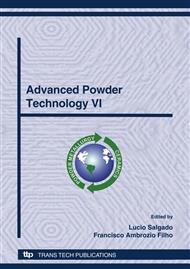p.628
p.634
p.639
p.644
p.649
p.654
p.661
p.667
p.673
Sintering of Y2O3-Stabilized ZrO2 Powders Obtained by Different Chemical Methods
Abstract:
The chemical methods allow obtaining powders with high reactivity and chemical homogeneity. This work studied the sintering of Y2O3-stabilized ZrO2 powders produced by polymerization routes. In the three methods used were obtained powders via formation of gels, which were characterized by spectroscopy in the infrared. After the gel calcinations, the powders obtained were characterized by X-ray diffraction and scanning electronic microscopy (SEM). Among the different chemical methods, there were differences in the coordination of the metallic ions, which caused differences in the thermal behavior, reactivity, size and form of the particles of the powders. The powders were pressed and sintered at 1400 and 1600°C for 2 hours. The bodies sintered were characterized by SEM, apparent density and dilatometry. The average size of the particles varied with the method, and the smallest particles were obtained by Pechini method. PCS method showed a strong reactivity of the powder and it was already partially sintered even in the step of elimination of organic substances. Similarly, the sintered compacts presented different properties with each other, and the compacts obtained by PEG/FA method had the best microstructure.
Info:
Periodical:
Pages:
649-653
Citation:
Online since:
August 2008
Price:
Сopyright:
© 2008 Trans Tech Publications Ltd. All Rights Reserved
Share:
Citation:


